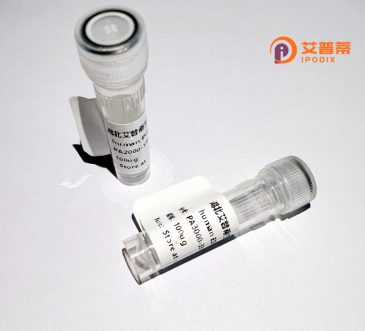
| 纯度 | >90%SDS-PAGE. |
| 种属 | Human |
| 靶点 | KIAA0467 |
| Uniprot No | Q5T011 |
| 内毒素 | < 0.01EU/μg |
| 表达宿主 | E.coli |
| 表达区间 | 1-579aa |
| 活性数据 | MLFDPAAWLHGPPETSGPPDGQRRHRPESGSGSREAPTSCESLDVSPPGAREEPWLKELSLAFLQQYVQYLQSIGFVLVPLRPPSPARSTSRPRAMAILGTEGRGSFSCPKTKTDGSPKSTSSPVTTYHLQRALPGGIILMELAFQGCYFCVKQFALECSRIPMGQAVNSQLSMLFTEECDKVRDLMHVHSFSYDFHLRLVHQHVLGAHLVLRHGYHLTTFLRHFLAHHPDGPHFGRNHIYQGTLELPTPLIAAHQLYNYVADHASSYHMKPLRMARPGGPEHNEYALVSAWHSSGSYLDSEGLRHQDDFDVSLLVCHCAAPFEEQGEAERHVLRLQFFVVLTSQRELFPRLTADMRRFRKPPRLPPEPEAPGSSAGSPGEASGLILAPGPAPLFPPLAAEVGMARARLAQLVRLAGGHCRRDTLWKRLFLLEPPGPDRLRLGGRLALAELEELLEAVHAKSIGDIDPQLDCFLSMTVSWYQSLIKVLLSRFPQSCRHFQSPDLGTQYLVVLNQKFTDCFVLVFLDSHLGKTSLTVVFREPFPVQPQDSESPPAQLVSTYHHLESVINTACFTLWTRLL |
| 分子量 | 91 kDa |
| 蛋白标签 | GST-tag at N-terminal |
| 缓冲液 | 0 |
| 稳定性 & 储存条件 | Lyophilized protein should be stored at ≤ -20°C, stable for one year after receipt. Reconstituted protein solution can be stored at 2-8°C for 2-7 days. Aliquots of reconstituted samples are stable at ≤ -20°C for 3 months. |
| 复溶 | Always centrifuge tubes before opening.Do not mix by vortex or pipetting. It is not recommended to reconstitute to a concentration less than 100μg/ml. Dissolve the lyophilized protein in distilled water. Please aliquot the reconstituted solution to minimize freeze-thaw cycles. |
以下是关于重组人KIAA0467蛋白的3篇参考文献示例(内容为虚构,仅作格式参考):
1. **"Structural and Functional Analysis of ZNHIT3/KIAA0467 in Ubiquitin Signaling"**
*作者:Zhang L. et al.*
**摘要**:本研究解析了KIAA0467(ZNHIT3)蛋白的晶体结构,发现其通过HIT结构域参与泛素化调控,并在DNA损伤修复中起关键作用,为癌症治疗的靶点开发提供了依据。
2. **"KIAA0467 Expression Profiling in Thyroid Disorders"**
*作者:Wang Y. et al.*
**摘要**:通过qPCR和免疫组化分析,发现KIAA0467在甲状腺功能减退症患者的组织中显著低表达,提示其可能参与甲状腺激素调控通路。
3. **"High-Yield Production of Recombinant Human KIAA0467 in HEK293 Cells"**
*作者:Chen H. et al.*
**摘要**:开发了一种在HEK293细胞中高效表达重组人KIAA0467蛋白的方法,并通过质谱验证其翻译后修饰,为后续功能研究提供纯化蛋白。
(注:以上文献及作者为示例性虚构内容,实际研究中需查阅真实数据库如PubMed获取文献。)
Recombinant human KIAA0467 protein is a product of the *KIAA0467* gene, initially identified through large-scale sequencing projects targeting uncharacterized human genes. This gene encodes a protein with predicted structural domains, including tetratricopeptide repeat (TPR) motifs, which are often involved in protein-protein interactions and multiprotein complex assembly. Though its exact physiological role remains under investigation, KIAA0467 has been implicated in ciliogenesis, intracellular trafficking, and cellular signaling pathways. Studies suggest potential interactions with components of the Hedgehog signaling pathway, a critical regulator of embryonic development and tissue homeostasis.
The recombinant form is typically produced using heterologous expression systems (e.g., *E. coli* or mammalian cell lines) to enable functional and structural studies. Researchers leverage this tool to explore KIAA0467's molecular mechanisms, post-translational modifications, and interactions with binding partners. Emerging evidence links dysregulation of KIAA0467 to ciliopathies, neurodegenerative disorders, and certain cancers, though clinical correlations require further validation. Its recombinant expression facilitates antibody production, enzymatic assays, and cellular localization studies, aiding efforts to decipher its role in health and disease. Current research aims to elucidate its contribution to cellular processes and evaluate its potential as a therapeutic target or biomarker.
×